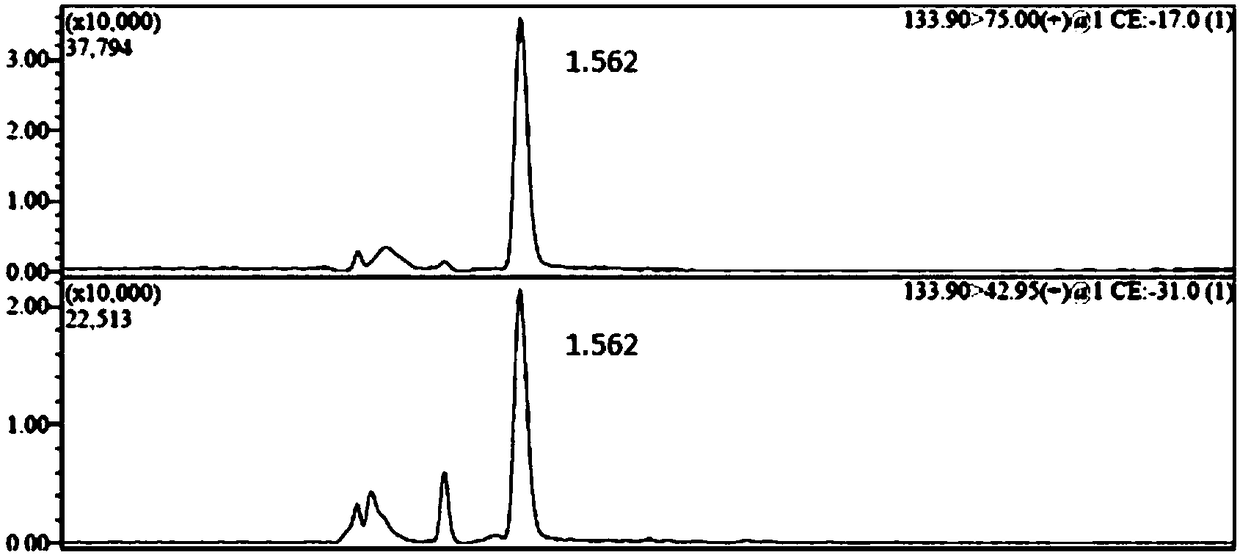Method for determining residual amount of thiediazole copper in dendrobium officinale
A technology of Dendrobium officinale and an analytical method, applied in the field of analysis of thiophanate copper residues in Dendrobium officinale, can solve the problems of matrix interference, unsatisfactory purification effect, low sensitivity and the like, and achieves less impurity interference, avoiding matrix interference, and recovery rate. high effect
- Summary
- Abstract
- Description
- Claims
- Application Information
AI Technical Summary
Problems solved by technology
Method used
Image
Examples
Embodiment 1
[0046] (1) Derivation: Weigh 5 g of Dendrobium officinale sample, put it in a stoppered Erlenmeyer flask, add 20 mL of 0.1 mol / L sodium sulfide solution, heat to 30°C, and shake for 30 minutes;
[0047] (2) Extraction: add 20 mL of acetonitrile, shake at room temperature for 1 hour, filter with suction after shaking, and use 1 mol / L H 2 SO 4 Adjust the pH to 4-5;
[0048](3) Extraction: Transfer the above solution to a separatory funnel, add 50 mL of ethyl acetate for extraction, take the upper organic phase, dry over anhydrous sodium sulfate, filter, and concentrate the filtrate to near-dryness under reduced pressure in a constant temperature water bath at 40 °C, add 2.0 mL of petroleum ether: acetone (1:1, v:v) dissolved, to be purified;
[0049] (4) Purification: take Florisil solid-phase column, activate with petroleum ether, take the above-mentioned extract to be purified and load it, elute with petroleum ether: acetone (1:1, v:v), collect eluent, reduce Concentrate un...
Embodiment 2
[0053] (1) Derivation: Weigh 10 g of Dendrobium officinale sample, put it in a stoppered Erlenmeyer flask, add 60 mL of 0.1mol / L sodium sulfide solution, heat to 60°C, and shake for 30 minutes;
[0054] (2) Extraction: add 60 mL of acetonitrile, shake at room temperature for 2 hours, filter with suction after shaking, and use 1 mol / L H 2 SO 4 Adjust the pH to 4-5;
[0055] (3) Extraction: Transfer the above solution to a separatory funnel, add 100 mL of ethyl acetate for extraction, take the upper organic phase, dry over anhydrous sodium sulfate, filter, and concentrate the filtrate to near-dryness under reduced pressure in a constant temperature water bath at 40 °C, add 2.0 mL of petroleum ether: acetone (1:1, v:v) dissolved, to be purified;
[0056] (4) Purification: take Florisil solid-phase column, activate with petroleum ether, take the above-mentioned extract to be purified and load it, elute with petroleum ether: acetone (1:1, v:v), collect eluent, reduce Concentrate...
Embodiment 3
[0060] (1) Derivation: Weigh 7.5 g of Dendrobium officinale sample, put it in a stoppered Erlenmeyer flask, add 20-60 mL of 0.1mol / L sodium sulfide solution, heat to 40°C and shake for 30 minutes;
[0061] (2) Extraction: Add 40 mL of acetonitrile, shake at room temperature for 1.5 hours, filter with suction after shaking, and use 1 mol / L H for the filtrate 2 SO 4 Adjust the pH to 4-5;
[0062] (3) Extraction: Transfer the above solution to a separatory funnel, add 70 mL of ethyl acetate for extraction, take the upper organic phase, dry over anhydrous sodium sulfate, filter, and concentrate the filtrate to near-dryness under reduced pressure in a constant temperature water bath at 40 °C, add 2.0 mL of petroleum ether: acetone (1:1, v:v) dissolved, to be purified;
[0063] (4) Purification: take Florisil solid-phase column, activate with petroleum ether, take the above-mentioned extract to be purified and load it, elute with petroleum ether: acetone (1:1, v:v), collect eluent...
PUM
| Property | Measurement | Unit |
|---|---|---|
| recovery rate | aaaaa | aaaaa |
Abstract
Description
Claims
Application Information
 Login to View More
Login to View More - R&D
- Intellectual Property
- Life Sciences
- Materials
- Tech Scout
- Unparalleled Data Quality
- Higher Quality Content
- 60% Fewer Hallucinations
Browse by: Latest US Patents, China's latest patents, Technical Efficacy Thesaurus, Application Domain, Technology Topic, Popular Technical Reports.
© 2025 PatSnap. All rights reserved.Legal|Privacy policy|Modern Slavery Act Transparency Statement|Sitemap|About US| Contact US: help@patsnap.com



